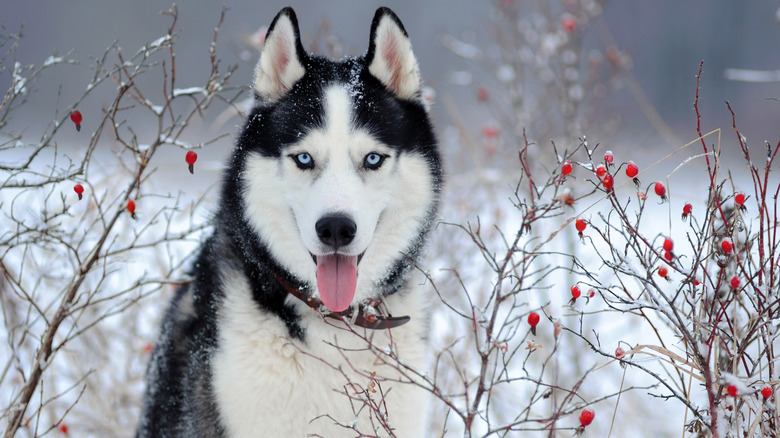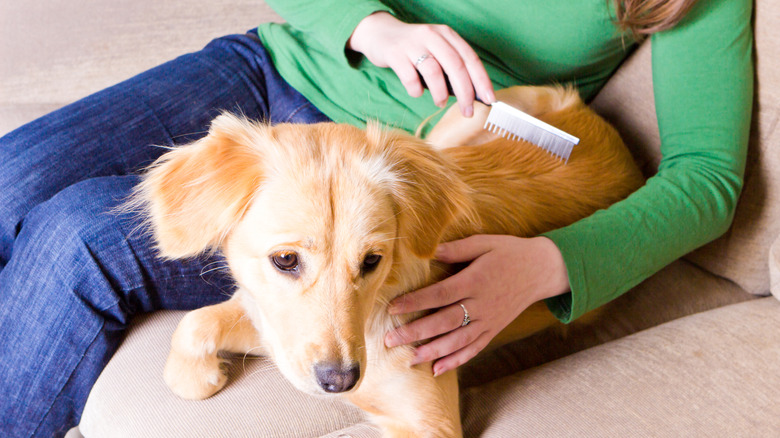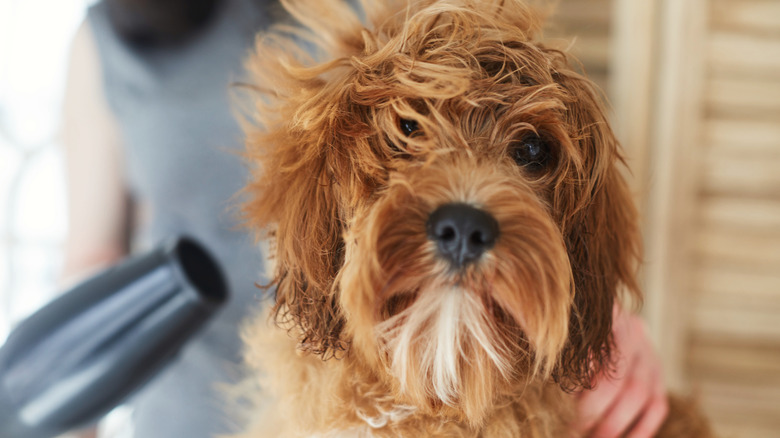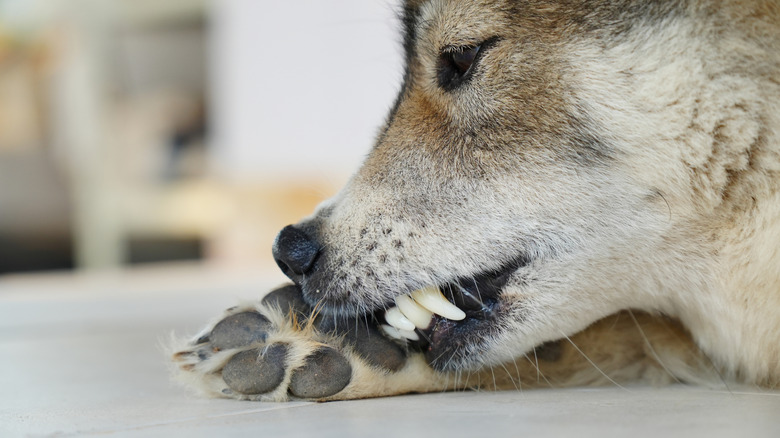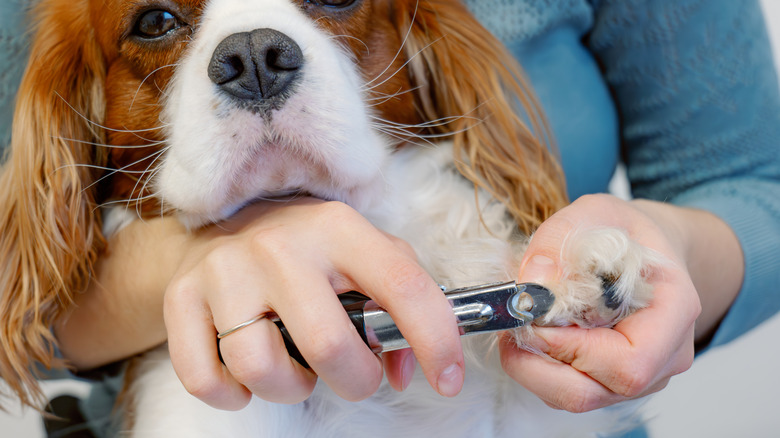What Not To Do When Grooming Your Dog For Winter
We may receive a commission on purchases made from links.
With holidays, cold weather, and indoor activities, grooming your dog may be the last thing on your mind in winter. However, it's important to keep up your grooming routines for your furry best friend, especially as the chilly months move in. Not only does it keep you on schedule for regular activities such as hair and nail trims, but it can also keep your dog feeling their best during the freezing weather.
Speaking to PetMD, veterinarian and journalist Dr. Jeff Werber, DVM, put it best: "A healthy coat is like a thermos—it acts as a temperature regulator, keeping warmth in during the winter and keeping heat out in summer." Keeping up that established grooming routine becomes even more important in extreme temperatures. Yet, while you may already know how to groom your dog for winter, there are some things you shouldn't do! Be sure to keep these grooming "don'ts" in mind the next time you get ready for your pup's seasonal care.
Don't skip your regular grooming routine
It's easy to fall out of routine grooming, especially in the busiest parts of winter. However, haircuts and baths are still beneficial for maintaining your dog's healthy coat and skin in cold temperatures. Even if you aren't able to bring them to the groomer as often, there are still some steps you can take at home. A moisturizing dog shampoo is perfect for keeping the skin soft and supple. Omega fatty acids supplements can also help keep the skin from getting too dry in colder months.
If you're skipping your dog's regular grooming appointments, make sure you're still brushing them daily. This is especially important for long-hair and curly-coated breeds like poodles whose coats may easily mat without daily care. Dr. Jeff Werber shared the best brushes to use for each coat type: "A short coat will be fine with a bristle brush, but a longer, thicker coat may require a stronger, more rigid brush. Some coats even require special tools to get through the thickness of the coat."
Don't forget to dry your dog's hair before going outside
When bathing your dog at home, make sure their coat is thoroughly dry before heading out on that walk. While your pup's thicker coat may have you believing they'll be okay in the chilly weather even if their coat is still damp, it's not true. It's best to use a pet-friendly blow dryer, such as the Shernbao High-Velocity Dog Dryer to get them completely dry. Your personal hair dryer can work in a pinch for spots such as your dog's ears or tail. Just make sure it's far enough away to not cause any burns.
The longer a wet dog is exposed to the cold, the more body heat they'll lose. This can lead to serious issues such as hypothermia. Be sure to keep an eye out for the signs of hypothermia if you do go out, such as increased panting, sluggishness, or even passing out. If you notice your dog experiencing these symptoms, bring them somewhere warm and contact your vet ASAP.
Dog sweaters and coats can help fend off some of the cold even if your dog is a little damp. However, it's important that those don't become wet, either. Wet sweaters can have the same effect as wet fur, making your canine even colder. Instead, make sure your dog is fully dry, and that you have a fresh, dry sweater to place on them.
Don't let mats build up in your dog's coat
When your dog's grooming routine is disrupted in winter months, you may also forget to regularly brush their fur. This can lead to matting in your dog's coat as hair tangles and is trapped against the body. Wet weather, such as heavy rain or snow, can also lead to wet hair that more easily mats and traps moisture. The mats can also cause discomfort, reduce insulation against the cold, and even lead to sores on the skin.
It's good to remember that matting can increase during seasonal shedding — namely from winter to spring, or fall to winter. This is why it's so important to keep up with daily brushing. Using a detangling conditioner at bath time can also help. It will loosen any smaller mats, especially on thick or curly-coated breeds that are more prone them. If your dog needs regular hair trims, scheduling a few grooming appointments over winter can also reduce mats.
Don't forget to groom between your dog's toes
Just as our fingers and lips get chapped in winter, your dog's paw pads can crack as cold weather hits. In addition, irritation from deicer granules, snow, and ice can all cause the paw pads to crack more easily. De-icers can contain ingredients that are harmful or irritating to your pet's paws. Wiping down paws with a pet wipe every time you come inside can remove anything before it becomes a problem.
Trimming the hair between your dog's toes can also help keep deicer granules and snowballs from getting stuck. It allows for pet wipes to get more easily between the toes, too. In addition, dog boots and natural paw waxes can help protect paw pads and treat any cracked pads. If you do notice an issue, such as sudden lameness, it's a good idea to check for any injuries or ice accumulation between your pup's toes.
Don't skip nail trims
Colder weather can sometimes mean less activity outside. Less activity, such as walks on harder pavements, means your dog's nails might not grind down as quickly as in summer months. If you hear any clicking sounds when your dog walks around, it means their nails are too long. Keeping nails short can also make it easier to get pet wipes between your dog's toes to clean them.
Regular nail trimming at home also gives you a chance to check your dog's feet for any issues from the cold or ice. Snow, ice balls, and even rocks can get stuck beneath long nails. If you decide to trim your dog's nails at home, the Yabife Nail Trimmer Kit is the perfect thing to have on hand with everything in one place. Along with following regular winter safety tips for protecting your dog against cold weather, the right grooming routine can help keep your pup comfortable all season.
